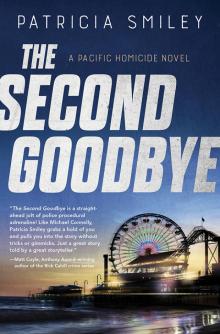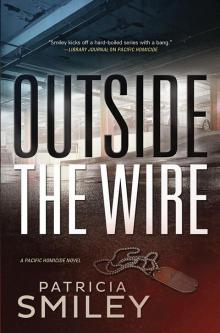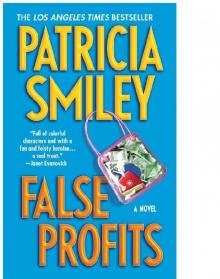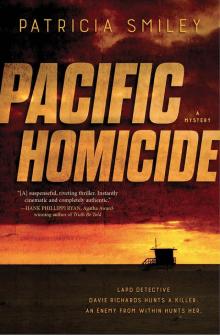- Home
- Patricia Smiley
Pacific Homicide
Pacific Homicide Read online
Dedicated to
Misty, Danny Boy, Aristede, Miss Scarlett, Dottie, PJ,
Tigger-Boo, Scooter, and Riley
For making my world a better place
Copyright Information
Pacific Homicide: A Mystery © 2016 by Patricia Smiley.
All rights reserved. No part of this book may be used or reproduced in any matter whatsoever, including Internet usage, without written permission from Midnight Ink, except in the form of brief quotations embodied in critical articles and reviews.
As the purchaser of this ebook, you are granted the non-exclusive, non-transferable right to access and read the text of this ebook on screen. The text may not be otherwise reproduced, transmitted, downloaded, or recorded on any other storage device in any form or by any means.
Any unauthorized usage of the text without express written permission of the publisher is a violation of the author’s copyright and is illegal and punishable by law.
This is a work of fiction. Names, characters, places, and incidents are either the product of the author’s imagination or are used fictitiously, and any resemblance to actual persons living or dead, business establishments, events, or locales is entirely coincidental.
First e-book edition © 2016
E-book ISBN: 9780738751306
Book format by Bob Gaul
Cover design by Lisa Novak
Cover art by iStockphoto.com/54877942/©rmbarricarte
Editing by Nicole Nugent
Midnight Ink is an imprint of Llewellyn Worldwide Ltd.
Library of Congress Cataloging-in-Publication Data
Names: Smiley, Patricia, author.
Title: Pacific homicide: a mystery / Patricia Smiley.
Description: First edition. | Woodbury, Minnesota: Midnight Ink, [2016] |
Series: A Pacific homicide mystery; #1
Identifiers: LCCN 2016026049 (print) | LCCN 2016033631 (ebook) | ISBN
9780738750217 | ISBN 9780738751306 (ebook)
Subjects: | GSAFD: Mystery fiction.
Classification: LCC PS3619.M49 P33 2016 (print) | LCC PS3619.M49 (ebook) |
DDC 813/.6—dc23
LC record available at https://lccn.loc.gov/2016026049
Midnight Ink does not participate in, endorse, or have any authority or responsibility concerning private business arrangements between our authors and the public.
Any Internet references contained in this work are current at publication time, but the publisher cannot guarantee that a specific reference will continue or be maintained. Please refer to the publisher’s website for links to current author websites.
Midnight Ink
Llewellyn Worldwide Ltd.
2143 Wooddale Drive
Woodbury, MN 55125
www.midnightinkbooks.com
Manufactured in the United States of America
Acknowledgments
I owe a debt of gratitude to many people who offered their wisdom and support during the long journey to complete this novel, including: Elizabeth George, Lee Goldberg, Karen E. Olson, Charlotte Herscher, Bonnie MacBird, Harley Jane Kozak, Matt Witten, Craig Faustus Buck, Linda Burrows, Bob Shane, Jonathan Beggs, Jamie Diamond, Sandy Harding, and Michael Levin. Thanks also to my attorney Jonathan Kirsch and to all the people at Midnight Ink, especially my editor Terri Bischoff, for transforming my manuscript pages into a real book.
While researching this novel, I interacted with many officers and detectives of the Los Angeles Police Department. Thanks to all who answered my questions and regaled me with their stories, especially Homicide Detective Michael D. DePasquale, who inspired me in countless ways. Any mistakes you may find in police procedures are mine alone. Things change, including the law and LAPD policies. For example, Homicide detectives have been moved out of area squad rooms and are now consolidated at regional Bureaus. That makes sense in the real world, because it’s a more efficient use of personnel. However, this is a work of fiction, so I chose to leave Pacific Homicide detectives where I first encountered them, in the Pacific Area squad room.
1
Detective Davie Richards arrived at Hyperion Sewage Treatment Plant near Dockweiler Beach on Tuesday morning at seven forty-five, shortly after an employee found what appeared to be a white female wedged between the claws of a rotating grinder.
Davie stood near the collection trough, studying what was left of the body. Part of the woman’s face was missing as well as her left arm and right leg. Clumps of long blonde hair surged in the cloudy water. Davie shifted her gaze, forcing herself to think of the wreckage as a discarded mannequin from a department store window and not as somebody whose loved ones were hoping for better news.
The air in the sewage plant had an oppressive chemical odor. She glanced at her partner, Jason Vaughn, as he pulled a tube of menthol vapor rub from the jacket pocket of his designer suit, which was more Wall Street bond trader than Homicide detective. All it would take was one bloody crime scene and those expensive threads would be history. He didn’t seem to care.
Vaughn dabbed the gel under his nose to mask the smell. “Good thing it’s the coroner’s job to dig her out of there. This could get messy.”
Davie had seen plenty of dead bodies before. She had been with the Los Angeles Police Department nine years—eight in patrol and one year as a detective. Some nights working mid–p.m. watch in Southeast patrol, she had raced from one homicide to the next like her hair was on fire, barely able to distinguish one victim from another when the DA’s office subpoenaed her to testify in court.
But she wasn’t likely to forget this crime scene.
She squatted next to the trough, arcing her gaze across the victim’s body for clues to her identity. The woman’s remaining limbs looked waxy and frail, as if she might have been anorexic. Her fingers were long and thin. No ring. No jewelry of any kind. It was difficult to determine her age, but judging by the length of her thighbone, she appeared to be an adult.
Her mouth was open and flaccid. Her parted lips exposed some sort of metal in her mouth. Braces. Davie remembered the pain from the wires she wore as a teenager. Being forced to wear braces as a teen was one thing; wearing them as an adult was quite another. She would eventually find out why the woman had waited so long to straighten her teeth. It was her job to learn everything she could about a victim. Cops often solved crimes because they noticed some small detail—
minutiae—that didn’t fit the pattern.
She raised her voice over the rumble of machinery and wastewater flowing into the facility as she pointed toward the body. “Take a look at her elbow.”
Vaughn moved toward the trough in one lanky, fluid motion. “Looks like a tattoo.”
“A spiderweb. That’s a prison tat. If she was in stir, she’s got a rap sheet.”
“Maybe she’s just a gangster wannabe. I wouldn’t spend too much time on this one, partner. She obviously committed suicide.”
“How do you figure?”
“She’s nude. In my experience, members of the female tribe always strip down before they pull the plug. You people just can’t face eternity in any outfit that goes out of style.”
“I doubt death by sewer will catch on with my so-called tribe.”
Vaughn’s grin was cocky. “Too bad you don’t qualify as a spokesperson, Davie. You’re not a woman. You’re a machine, a ghetto gunslinger, a red-haired ninja. I mean that in a good way, of course.”
“I’m sure you do.”
She knew her partner was teasing. It was the way they related to each other. She also knew he was wise to be cautious. Back in his patrol days, a fe
male officer had filed a mouth beef against him over a dumb-blonde joke. The personnel complaint had cost him an eight-day suspension for sexual harassment. He hadn’t been promoted for five years after that, a standard department punishment.
“Call the coroner,” she said, “and SID. Ask them to send a photographer.”
“Why the paparazzi? Even if the vic was murdered, I doubt it happened here. The body looks like it’s been on the road for a while. Take a few shots with the camera in your war bag and call it a day.”
She made no attempt to conceal her irritation. “That’s why we have a Scientific Investigation Division, Jason. They have people who can take pictures of the body before the coroner moves it. Stop whining and make the call, okay?”
He held up his hands in surrender. “Whatever you say, partner.”
Vaughn was probably right. The LAPD’s crime scene mantra of “Look around, don’t walk around” didn’t apply here. It was unlikely she’d find any evidence to collect at the plant, but this was her first call-out as lead Investigative Officer at Pacific Homicide, and she couldn’t afford any screw-ups. She was already under investigation for an officer-involved shooting that had happened six months before. The LAPD brass had ruled the shooting was within policy, but until the police commission agreed with that decision, she felt like she was balancing on the sharp edge of a knife.
The air inside the building felt cold. Davie raised her shoulders toward her ears, wondering why that gesture always quelled a chill. Was it scientific or just her imagination? A moment later she heard footsteps and turned to see a black man in a hard hat walking toward her, carrying a large roll of paper under his arm.
The man towered over her by at least a foot. Six-two, she guessed. He looked to be in his early fifties, judging by the slouch of his shoulders, and the fat around his gut. A wedding band cut into his flesh. He’d probably gained weight over the years but never had the ring resized. Maybe he was superstitious about taking it off his finger or maybe he just couldn’t get it off.
As they exchanged introductions, engineer Casper Blount’s gaze swept down her size-zero black polyester pantsuit to her rubber-soled Oakley boots. Vaughn called them Special Ed shoes, but she could run in them and that’s all that mattered. She knew the Smith & Wesson .45-caliber pistol holstered on her belt looked like a cannon against her small frame, but she’d chosen it over the department-issued weapon because it made a statement: I might be small but I’m a force to be reckoned with.
Blount’s brown eyes lingered for a moment on the detective badge hanging from her belt. She didn’t need psychic powers to read his mind. He thought she looked like a teenager playing dress up. At least he was smart enough to keep his opinions to himself.
“Has a body ever surfaced at the plant before?” she said.
“Not that I remember. This has been quite a shock. One of my employees called about an hour ago. Said there was something caught in the machine and could I come down and take a look. That’s when we found her.”
“How do you think she got in the grinder?”
Blount explained in detail how gravity propelled sewage through the system of pipes and connectors while Davie made Sewer 101 notes on her chronological report.
“Your partner asked me to show you a map of the plant,” he said, “to help you understand the layout.”
Blount bent toward her to compensate for the difference in their heights as he unrolled the tube of paper. He pointed to an aerial drawing of the Hyperion facility that reminded her of a hodgepodge of circles and squares on a high school geometry quiz.
“The facility receives four hundred fifty million gallons of effluent on a normal day, more when it rains.” As he spoke, his finger traced over the four major sewer lines that merged into a tunnel under Imperial Highway and eventually surfaced as a river at Hyperion.
“Why didn’t the equipment process the body and move it on?”
“There are several mechanisms to remove solids,” he said. “The rotating grinder macerates oversized particles. Screens and bars remove what’s left. In this case, the grinder couldn’t handle the body. That’s why it jammed.”
“Could she be an employee?”
“I checked. All of our people are accounted for.”
Davie saw Vaughn standing near a round tank a short distance away, holding his cell phone. He shook his head, indicating he was still waiting for word about the photographer.
“The victim probably didn’t die here,” Davie said. “If this turns out to be a homicide, I need to trace the body back to the place where she entered the sewer system. Can you calculate how fast the wastewater travels through the tunnels and give me a timeline?”
Blount frowned as he rolled up the drawing. “I’m afraid that’s not possible.”
With all the math and science in the world, Davie wondered why one sewer geek couldn’t figure out how fast shit traveled.
“Why is that?”
Blount straightened his spine, widening the distance between them. “The wastewater system serves almost four million people in Los Angeles plus twenty-seven surrounding cities. There are more than sixty-five hundred miles of sewer pipelines. She could have entered almost anywhere. The path of debris isn’t always straightforward. As for the timeline, the body could have snagged on one of the underground ladders and stayed there until the force of the flow broke her loose. That could have taken hours or days.”
“Could that force tear a body apart?”
“Possibly.”
“So we’re back to square one. How could she get into the sewer?”
“There are only two ways,” Blount said. “Somebody could have thrown her into an open pipe while the line was under construction, but that’s unlikely. Those areas are generally blocked off. More likely, somebody dropped the body into a manhole. It slipped through the grates and entered the system. There are thousands of manholes, and they’re easily accessible to the public. Some of the covers weigh up to three hundred pounds and require a special tool to open them, but most can be lifted by one person.”
“I need a list of locations.”
He hesitated before responding. “All of them?”
Davie understood it would be a challenge to find the body’s point of entry, but it was her job to try.
“Yes,” she said. “All of them.”
He took in a breath, holding the air for a moment before letting it out. “I have maps. They’re in my office.”
Blount left the room just as Vaughn’s cell phone rang. He listened a moment before ending the call.
“Doctor Death and the photog just arrived,” he said, walking toward her. “Prepare to be underwhelmed.”
While her partner interviewed Hyperion employees, Davie supervised the photographer and watched as the coroner’s investigator extracted the remains from the grinder. The body revealed no obvious clue as to cause of death. She could only hope the medical examiner could sort that out at the autopsy. Davie jotted notes in her log as the tech bagged and tagged the victim as Jane Doe #3, the third unidentified female to die in Los Angeles County since the beginning of the year, just one week ago.
There was only one chance to process a crime scene. Once the yellow tape was removed, people would walk through the area and contaminate any remaining evidence. But contamination wasn’t a factor here. Even though she had assigned a patrol officer at the door to keep out unauthorized personnel, it was mostly for show. There were no blood spatters or shell casings to collect and nothing to fingerprint, so at nine forty-five a.m., two hours after she had arrived, Davie notified Blount that she had finished collecting evidence at Hyperion and officially closed the crime scene.
The gurney’s wheels bumped over the floor as the techs transported the body from the building. Davie thought about Blount’s lecture: four hundred and fifty million gallons of daily sewage flowing in rivers of brown sludge be
neath the streets of Los Angeles. Flushing toilets sent effluent surging into wastewater pipes four inches in diameter, which then gushed through sewer mains eight inches wide. The mains flowed into sixteen-inch laterals. Gravity propelled the waste into pipes, collectors, trunk lines, and then interceptors eleven feet across, spilling to downstream outfalls up to twelve and a half feet wide. All that waste was destined for four sewage treatment plants, one of them being the Hyperion location. Tumbling, cascading torrents of bacteria-filled muck and the body of one young woman known only as Jane Doe #3.
Davie felt perspiration form on her chest. It was certainly not the temperature in the room that made her sweat, but the image of the woman flailing in a dark tunnel as raw sewage swept her toward the sea. She closed her eyes to redirect her thoughts, hoping for the victim’s sake that she had been dead before she went underground.
2
The ocean bordering Playa del Rey was the same shade of flinty gray as the sky as Davie left Hyperion and drove back to the station in the only car that had been available that morning, a beat-up VW Jetta she had borrowed from Vice detectives.
A winter cold front from Alaska had blown into town for an unwelcome stay. People from Chicago joked when Angelenos complained about forty-degree weather, but Davie figured the hairs in your nose didn’t have to freeze and break off before you could call the weather what it was: chilly.
Vaughn sat in the passenger seat checking the value of his stock portfolio on an iPhone. She didn’t ask how he transitioned so easily between death and price-to-earnings ratios. It didn’t matter. Vaughn was the closest thing she had to a friend in the department. They were the same age, thirty-one. They had graduated from the same academy class and had stayed in touch over the years. They hadn’t worked together until recently, but Vaughn had her back, and that made him as close to perfect as a partner could get. Besides, she appreciated the silence. It gave her time to think. With luck, someone had reported the victim missing. Even with that information, learning how she had died might be difficult. Davie refused to say impossible because cynicism was a detective’s enemy.

 The Second Goodbye
The Second Goodbye Outside the Wire
Outside the Wire False Profits
False Profits Cover Your Assets
Cover Your Assets Pacific Homicide
Pacific Homicide Cool Cache
Cool Cache